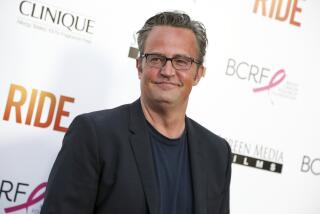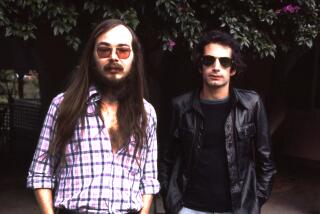Owsley Stanley dies at 76; ‘Acid King’ of the ‘60s psychedelic era
- Share via
Nearly everyone familiar with the history of the 1960s has heard of Timothy Leary and Ken Kesey, the pranksters who spread the gospel of psychedelics to the countercultural generation. But far fewer remember Owsley Stanley.
Stanley, who died Saturday at age 76, was arguably as pivotal as Leary and Kesey for altering minds in the turbulent ‘60s. Among a legion of youthful seekers, his name was synonymous with the ultimate high as a copious producer of what Rolling Stone once called “the best LSD in the world … the genuine Owsley.” He reputedly made more than a million doses of the drug, much of which fueled Kesey’s notorious Acid Tests — rollicking parties featuring all manner of psychedelic substances, strobe lights and music. Tom Wolfe immortalized Stanley as the “Acid King” in the counterculture classic “The Electric Kool-Aid Acid Test” (1968).
The music that rocked Kesey’s events was made by the Grateful Dead, the iconic rock band of the era that also bears Stanley’s imprint. His chief effect on the band stemmed not merely from supplying its musicians with top-grade LSD but from his technical genius: As the Dead’s early sound engineer, Stanley, nicknamed “Bear,” developed a radical system he called the “wall of sound,” essentially a massive public address system that reduced distortion and enabled the musicians to mix from the stage and monitor their playing.
“Owsley was truly important in setting the example of someone who would go to almost any length, beyond what anyone would think reasonable, to pursue the goal of perfection … sonic perfection, the finest planet Earth ever saw,” Grateful Dead publicist Dennis McNally said Monday. “They never would have done that without Bear. Furthermore, the greater San Francisco scene never would have been what it was without the opportunity for thousands of people to experience psychedelics, which would not have happened without Bear.”
Stanley, who moved to Australia more than 30 years ago, was driving his car in a storm near the town of Mareeba in Queensland when he lost control and crashed, said Sam Cutler, a longtime friend and former Grateful Dead tour manager. He died at the scene. His wife, Sheilah, sustained minor injuries.
Described by Cutler as a man who held “very firm beliefs about potential disasters,” Stanley relocated to Australia because he believed it was the safest place to avoid a new ice age. He was a fanatical carnivore who once said that eating broccoli may have contributed to a heart attack several years ago. In his later years he was mainly a sculptor and jeweler, and his works were sought by many in the music industry, including the Rolling Stones’ Keith Richards, Cutler said.
“He was a very sophisticated man,” Cutler said, “an amalgam of scientist and engineer, chemist and artist.”
With artist Bob Thomas, Stanley designed the Dead’s distinctive logo: a skull emblazoned with a lightning bolt. He also recorded about 100 of the band’s performances, many of which later were released as albums. He once said that he considered preserving the live concerts one of his most important accomplishments.
Born Augustus Owsley Stanley III in Kentucky on Jan. 19, 1935, he was the grandson of a Kentucky governor and son of a naval commander. His nickname, Bear, reputedly was inspired by the profuse chest hair he sprouted in adolescence.
He studied engineering briefly at the University of Virginia before dropping out and joining the Air Force, where he trained as a radio operator. After completing his military service in 1958, he moved to California and worked at a variety of jobs, including a stint at the Jet Propulsion Laboratory in La Cañada Flintridge. He also studied ballet, Russian and French.
He enrolled at UC Berkeley in 1963 as the Free Speech Movement was erupting and drugs such as LSD began flowing. He got his first taste of LSD in April 1964. “I remember the first time I took acid and walked outside,” he told Rolling Stone in 2007, “and the cars were kissing the parking meters.”
That experience convinced him that he needed a steady and trustworthy supply. He found a recipe at the campus library. Then, with a chemistry major named Melissa Cargill, he started a lab and began manufacturing a very pure form of the drug.
His lab was raided twice; Stanley spent two years in prison. According to “A Long Strange Trip,” McNally’s history of the Grateful Dead, Stanley estimated that he had produced enough LSD to provide about 1.25 million doses between 1965 and 1967.
After his release from prison in 1972, he returned to the Dead and began working on a new sound system, a monolithic collection of speakers and microphones that channeled the music through a single cluster of equipment. The band introduced it in 1974 at San Francisco’s Cow Palace, but it was too expensive to sustain and Stanley later gave most of it away. But his ideas were later adopted by concert equipment makers.
Not everyone was a fan of the system. “It was always malfunctioning,” Country Joe McDonald, of the ‘60s psychedelic band Country Joe & the Fish, said in an interview Monday. “The Grateful Dead and their extended family were like a unit, a nine-headed hydra. They did things their own way. People loved it. It was part of their mystique.” Stanley, whom McDonald knew slightly and remembered as “kind of an obnoxious” person, “fit in really well.”
For a brief time Stanley was the Grateful Dead’s main financial backer and put them up in a pink stucco house in Watts, where he had moved his LSD lab. A 1966 Los Angeles Times profile described Stanley roaring up to a Sunset Boulevard bank on a motorcycle with wads of money crammed in his helmet, pockets and boots. The Times’ and other accounts described him as an LSD millionaire, a status Stanley denied. But it inspired a Dead song, “Alice D. Millionaire.” He also was immortalized in a Steely Dan composition, “Kid Charlemagne,” and in a Jimi Hendrix recording of the Beatles’ “Day Tripper,” in which Hendrix can be heard calling out “Owsley, can you hear me now?”
Stanley downplayed his influence on the psychedelic explosion, explaining that he began producing LSD only to ensure the quality of what he ingested.
“I just wanted to know the dose and purity of what I took into my own body. Almost before I realized what was happening, the whole affair had gotten completely out of hand. I was riding a magic stallion. A Pegasus,” he told Rolling Stone. “I was not responsible for his wings, but they did carry me to all kinds of places.”
In addition to his wife, he is survived by sons Pete and Starfinder; daughters Nina and Redbird; eight grandchildren; and two great-grandchildren.
More to Read
Start your day right
Sign up for Essential California for the L.A. Times biggest news, features and recommendations in your inbox six days a week.
You may occasionally receive promotional content from the Los Angeles Times.







